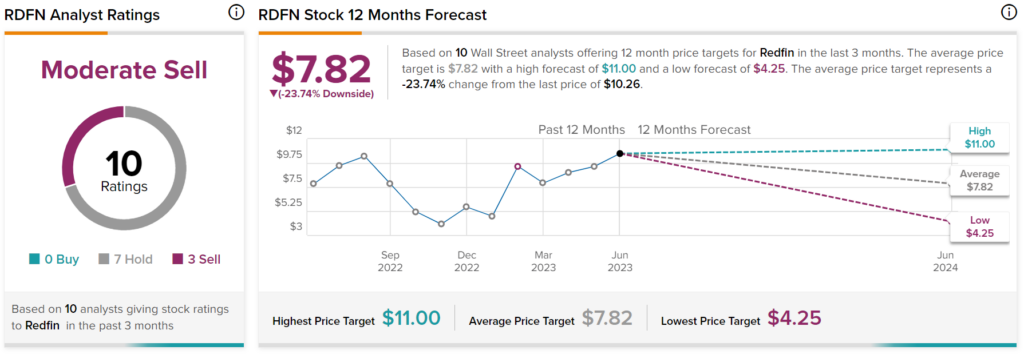With prices soaring everywhere, complaining about real estate accessibility has become almost a national pastime, which on one angle, might benefit the contrarian trade for sector brokerage Redfin (NASDAQ:RDFN). Though it suffers a moderate sell consensus rating from analysts, shares could potentially rise higher as housing experts argue that this time, it’s different. However, history might disagree with that point. As a result, I am bearish on RDFN stock.
RDFN Stock Partially Appears as Worthwhile Speculation
With the Federal Reserve committed to tackling the skyrocketing inflation that sparked around late 2021 to early 2022, housing seemingly has no other direction to go but down. Indeed, with the benchmark interest rate rising, borrowing costs necessarily rise with it. This dynamic should crimp housing demand. However, real estate remains considerably elevated against pre-pandemic norms, suggesting that RDFN stock might be worthwhile speculation.
Last month, TipRanks reporter Michael Marcus reported that some analysts have become bullish on the housing sector, particularly homebuilders such as PulteGroup (NYSE:PHM) and DR Horton (NYSE:DHI). Specific to the home building industry, a collectively strong earnings print for the first quarter of this year lifted confidence. Fundamentally, the usual suspects – low inventory, job growth, and overall economic stability (with some scratches and bruises) – supported optimism.
To be fair, it’s not completely unreasonable to be bullish on housing-related investments such as RDFN stock. For example, the May jobs report showed that the economy added 339,000 jobs, well above economists’ consensus forecast of 190,000. Sure, housing prices have moved up. However, under this context, more dollars from more employed individuals are chasing after fewer goods, the colloquial definition of inflation.
And “fewer goods” is the understatement of the century when it comes to housing. On that note, most circumstances seem well for RDFN stock. And that’s all the more reason why investors can’t afford to get complacent.
A Message from the Past Might Haunt Redfin
Neil Barsky, writing for The Wall Street Journal, provided another compelling argument supporting the continued rise of real estate and, by logical deduction, sector-related assets like RDFN stock. In fact, the contributor emphatically stated the main thesis. “The reality is this: There is no housing bubble in this country. Our strong housing market is a function of myriad factors with real economic underpinnings.”
Some of these underpinnings included job growth (a consistent theme throughout the post-pandemic recovery period) and “a serious housing shortage and housing affordability crisis.” While the latter point isn’t encouraging for modest-income workers looking to purchase a home, the reality is this: higher demand and low supply practically guarantee soaring prices. Basically, it’s Capitalism 101.
Here’s the catch, though. If you thought that Barsky wrote the above argument recently, you’d be forgiven, but you’d also be wrong. Rather, the author wrote the piece entitled “What Housing Bubble?” in July 2005, just a few months before housing prices peaked in early 2006.
To be sure, real estate bull market apologists will counter that this time, it’s different. With people building equity in their homes and locked in at ultra-low interest rates, a sector collapse isn’t likely. However, investors should be aware that back in the pre-housing crash of the mid-2000s decade, the experts were also saying that this time was different, stating that a Japan-style bubble burst (of the 1980s) wasn’t likely.
Strikingly, at the time, experts argued that a likelier risk factor – per an NBC News report in April 2004 – was that sales would just slow rather than pop outright.
The experts were wrong then. They could be wrong now.
Redfin’s Financials Don’t Offer Much Confidence
Drilling into RDFN stock specifically, the central issue centers on a decided lack of demand. More than likely, those with means already acquired their real estate. Moving forward, largely the stragglers remain, which isn’t helpful for the housing sector. Essentially, rising borrowing costs haven’t substantively reduced home prices, leading to a standstill. You can see it in the numbers. In Q1 2023, Redfin posted only $325.66 million in revenue, down 45.5% against the year-ago quarter’s tally of $597.35 million. Moreover, the top line has been dwindling on a consecutive basis since Redfin posted $606.91 million in sales for Q2 2022.
Further, with the company continually incurring net losses and negative free cash flow, circumstances don’t seem that pleasant for RDFN stock.
Is RDFN Stock a Buy?
Turning to Wall Street, RDFN stock has a Moderate Sell consensus rating based on zero Buys, seven Holds, and three Sell ratings. The average RDFN price target is $7.82, implying 23.74% downside potential.

The Takeaway: For RDFN Stock, It’s the Same Story All Over Again
Throughout the post-pandemic real estate bull run, the experts assuaged skeptics stating that this time, it’s different. Low inventory, job growth, economic stability, and so on. As well, if a downcycle occurs, it will be a gradual correction rather than an implosion. While no one can predict what will happen next with absolute authority, it’s irresponsible to assume the worst-case scenario can’t materialize. It’s happened before, and the current dynamics for RDFN stock seem eerily familiar.
















